2013 VOLKSWAGEN GOLF GTI light
[x] Cancel search: lightPage 141 of 319

Luggage compartment
Introduction
In this section you’ll find information about:
Folding the rear seat backrest forward and back into place
Luggage compartment cover
Luggage compartment pass-through
Tie-downs
Shopping bag hooks
Always stow heavy objects in the luggage compartment and make sure that the rear seat backrests
are securely latched in their upright position. Always secure objects to the tie-downs with suitable
straps. Never overload the vehicle. Remember that the vehicle load, as well as how it is distributed,
can affect vehicle handling and braking ⇒ .
More information:
�x Safety belts
�x Airbag system
�x Lights
�x Transporting
�x Trailer towing
�x Tires and wheels
WARNING
An open or unlocked luggage compartment poses special risks for children.
�x Close and lock the rear hatch and all doors when the vehicle is not in use. First, make
certain that no one is left inside.
�x Never leave your vehicle unattended or let children play around the vehicle, especially
with the rear hatch left open. A child could crawl into the vehicle and pull the hatch shut,
becoming trapped and unable to get out. This could cause severe or fatal injuries.
�x A closed vehicle can become very hot or very cold, depending on the season.
Temperatures can quickly reach levels that can cause unconsciousness or death, particularly
to small children.
�x Never let children play in or around the vehicle.
�x Never let anyone ride in the luggage compartment.
Page 150 of 319
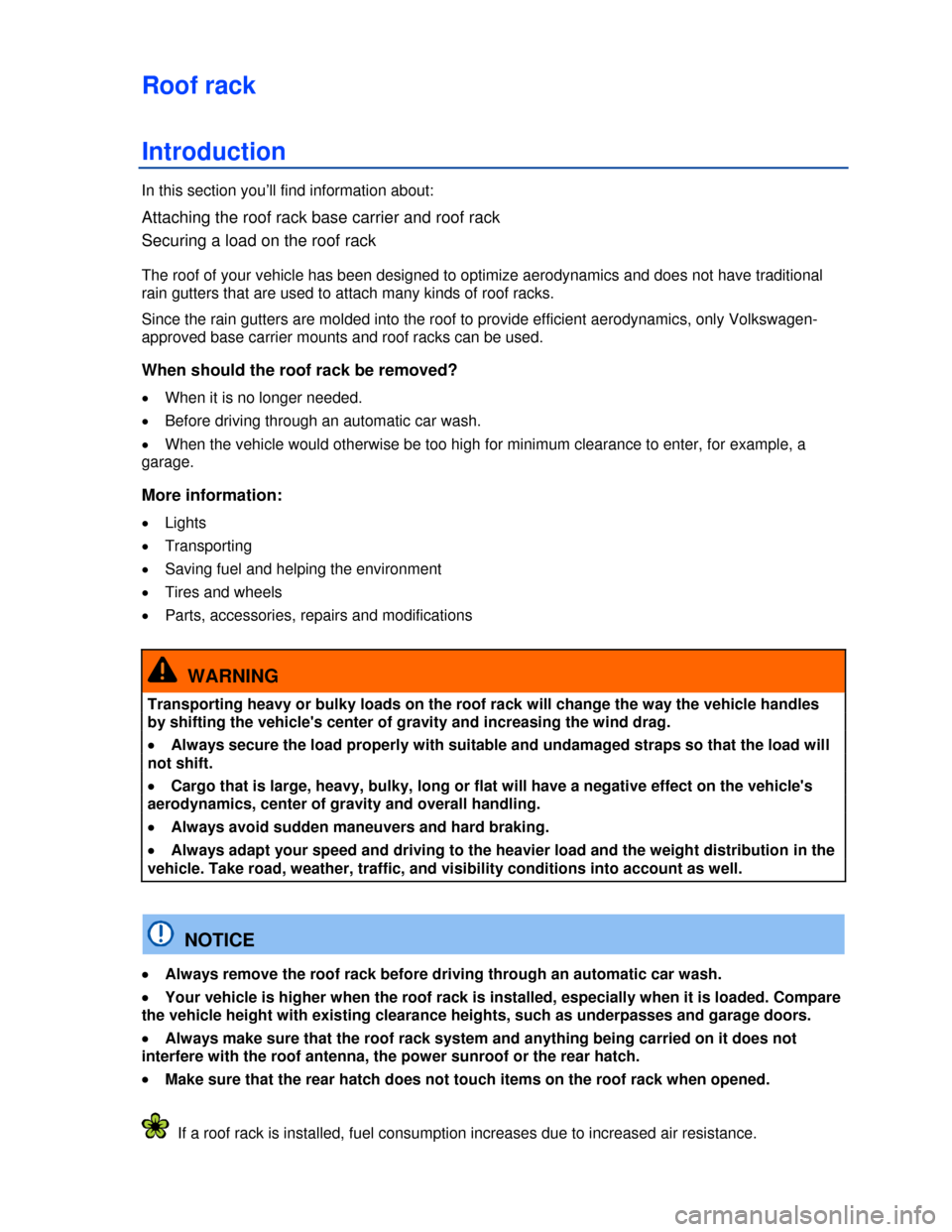
Roof rack
Introduction
In this section you’ll find information about:
Attaching the roof rack base carrier and roof rack
Securing a load on the roof rack
The roof of your vehicle has been designed to optimize aerodynamics and does not have traditional
rain gutters that are used to attach many kinds of roof racks.
Since the rain gutters are molded into the roof to provide efficient aerodynamics, only Volkswagen-
approved base carrier mounts and roof racks can be used.
When should the roof rack be removed?
�x When it is no longer needed.
�x Before driving through an automatic car wash.
�x When the vehicle would otherwise be too high for minimum clearance to enter, for example, a
garage.
More information:
�x Lights
�x Transporting
�x Saving fuel and helping the environment
�x Tires and wheels
�x Parts, accessories, repairs and modifications
WARNING
Transporting heavy or bulky loads on the roof rack will change the way the vehicle handles
by shifting the vehicle's center of gravity and increasing the wind drag.
�x Always secure the load properly with suitable and undamaged straps so that the load will
not shift.
�x Cargo that is large, heavy, bulky, long or flat will have a negative effect on the vehicle's
aerodynamics, center of gravity and overall handling.
�x Always avoid sudden maneuvers and hard braking.
�x Always adapt your speed and driving to the heavier load and the weight distribution in the
vehicle. Take road, weather, traffic, and visibility conditions into account as well.
NOTICE
�x Always remove the roof rack before driving through an automatic car wash.
�x Your vehicle is higher when the roof rack is installed, especially when it is loaded. Compare
the vehicle height with existing clearance heights, such as underpasses and garage doors.
�x Always make sure that the roof rack system and anything being carried on it does not
interfere with the roof antenna, the power sunroof or the rear hatch.
�x Make sure that the rear hatch does not touch items on the roof rack when opened.
If a roof rack is installed, fuel consumption increases due to increased air resistance.
Page 153 of 319

Trailer towing
Introduction
In this section you’ll find information about:
Technical requirements
Hitching up and connecting a trailer
Loading the trailer
Driving with a trailer
Ball mount
Retrofitting a trailer hitch
Maximum permissible trailer weight
Obey country-specific requirements about trailer towing and trailer hitches.
Volkswagen does not recommend installing a trailer hitch on your vehicle. Your Volkswagen was
mainly designed for carrying passengers. If you plan to tow a trailer, please remember your vehicle will
be performing a job for which it was not primarily intended. The additional load will affect durability,
handling, fuel economy, and performance, and may require the vehicle to be serviced more often.
Trailer towing not only places more stress on the vehicle, it calls for more concentration from the
driver. Always follow the operating and driving instructions given, and use common sense.
Under winter conditions, install winter tires on the vehicle and the trailer.
Tongue weight
The maximum permissible trailer tongue weight exerted on the ball mount must not exceed 200 lbs
(91 kg).
More information:
�x Power locking and closing system
�x Anti-theft alarm system
�x Lights and vision
�x Braking, stopping, and parking
�x Saving fuel and helping the environment
�x Starting assistance systems
�x Tires and wheels
�x Parts, accessories, repairs and modifications
WARNING
Riding in a trailer is dangerous and may be illegal.
Page 154 of 319

WARNING
Improper use of the trailer hitch can cause accidents and injuries. An improperly installed,
incorrect, or damaged trailer hitch can cause the trailer to separate from the towing vehicle
and cause serious personal injuries.
�x Only use an undamaged, properly mounted trailer hitch.
�x Never repair or modify the trailer hitch.
�x To reduce the risk of injury in rear-end collisions, and the risk to pedestrians and cyclists
when the vehicle is parked, always remove the ball mount when you are not towing a trailer.
�x Never install a “weight distributing” or “load equalizing” trailer hitch on your vehicle. The
vehicle was not designed for these kinds of trailer hitches. The trailer hitch attachment can
fail, causing the trailer to tear loose from the vehicle.
WARNING
Improper trailer towing can cause loss of vehicle control and serious personal injury.
�x Driving with a trailer and carrying heavy or large things can change the way the vehicle
handles, increase the distance it needs to stop safely, and cause accidents.
�x Always secure the load properly with suitable and undamaged straps so that the load will
not shift.
�x Always adapt your speed and driving to the heavier load and the weight distribution in the
vehicle. Take road, weather, traffic, and visibility conditions into account as well.
�x Reduce your speed even more than you otherwise would when going downhill and under
unfavorable load, weather, or wind conditions.
�x Trailers with a high center of gravity tip more easily than trailers with a low center of
gravity.
�x Always avoid sudden maneuvers and hard braking.
�x Be especially careful when passing other vehicles.
�x Reduce speed immediately if the trailer shows the slightest sign of swaying.
�x Never try to stop the swaying by accelerating.
�x Always obey speed limits. In some areas, the speed limits for vehicles towing trailers are
lower than for vehicles without trailers. Never drive faster than 50 mph (80 km/h; under
exceptional circumstances 60 mph - 100 km/h) when towing a trailer. This applies even if the
local speed limit is higher.
If you are driving a new vehicle or a vehicle with a new or rebuilt engine, do not tow a trailer
during the break-in period, about 600 miles (1000 km)
If you tow a trailer, your vehicle may need maintenance more often because of the extra load it
has to move.
When you are not towing, remove the trailer hitch ball. This helps keep the trailer hitch from
causing damage to your vehicle and to others if your vehicle is hit from behind.
Some models need a trailer hitch to tow or tow-start other vehicles. You may want to always
carry the ball mount in the vehicle after it has been removed. Be sure to stow it securely.
Page 156 of 319
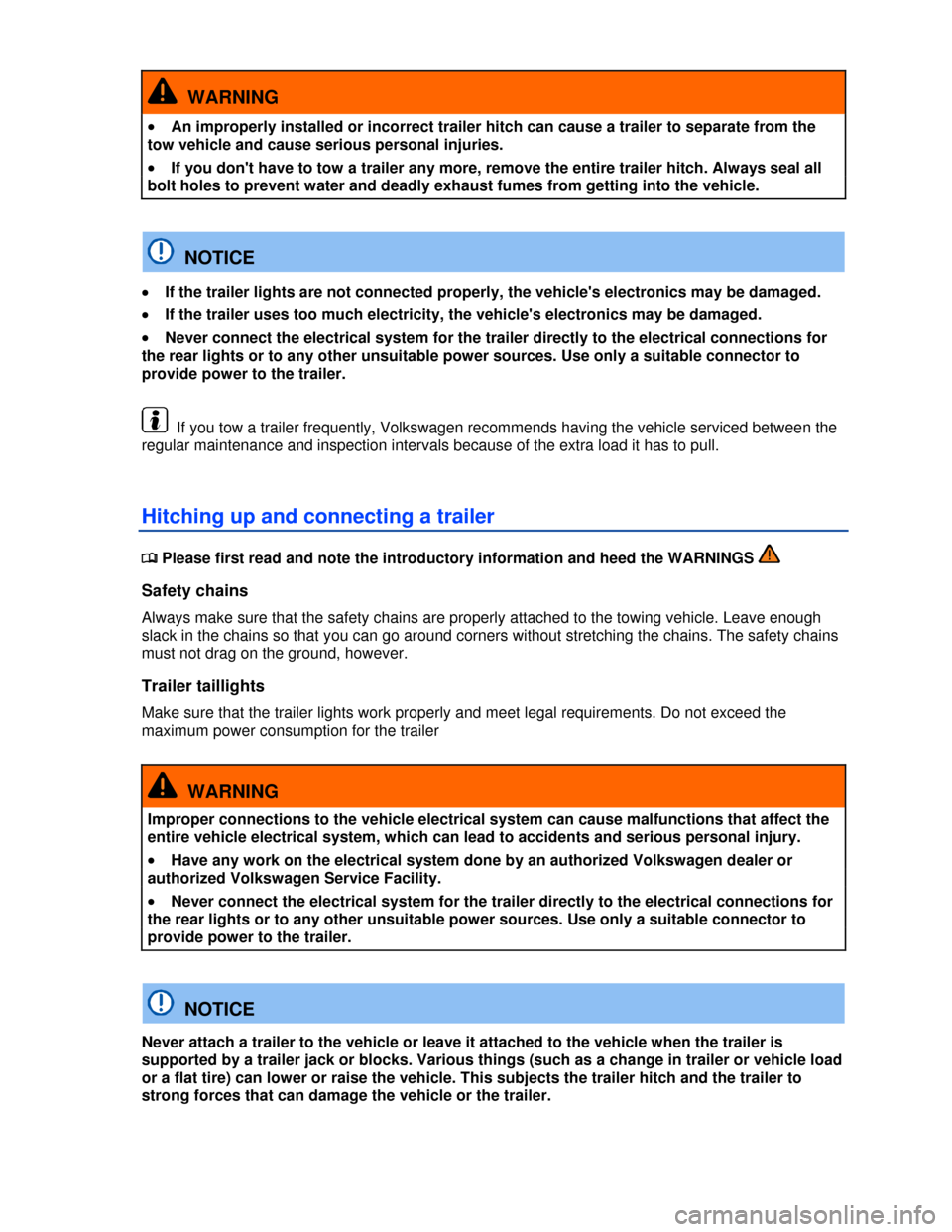
WARNING
�x An improperly installed or incorrect trailer hitch can cause a trailer to separate from the
tow vehicle and cause serious personal injuries.
�x If you don't have to tow a trailer any more, remove the entire trailer hitch. Always seal all
bolt holes to prevent water and deadly exhaust fumes from getting into the vehicle.
NOTICE
�x If the trailer lights are not connected properly, the vehicle's electronics may be damaged.
�x If the trailer uses too much electricity, the vehicle's electronics may be damaged.
�x Never connect the electrical system for the trailer directly to the electrical connections for
the rear lights or to any other unsuitable power sources. Use only a suitable connector to
provide power to the trailer.
If you tow a trailer frequently, Volkswagen recommends having the vehicle serviced between the
regular maintenance and inspection intervals because of the extra load it has to pull.
Hitching up and connecting a trailer
�
Page 159 of 319
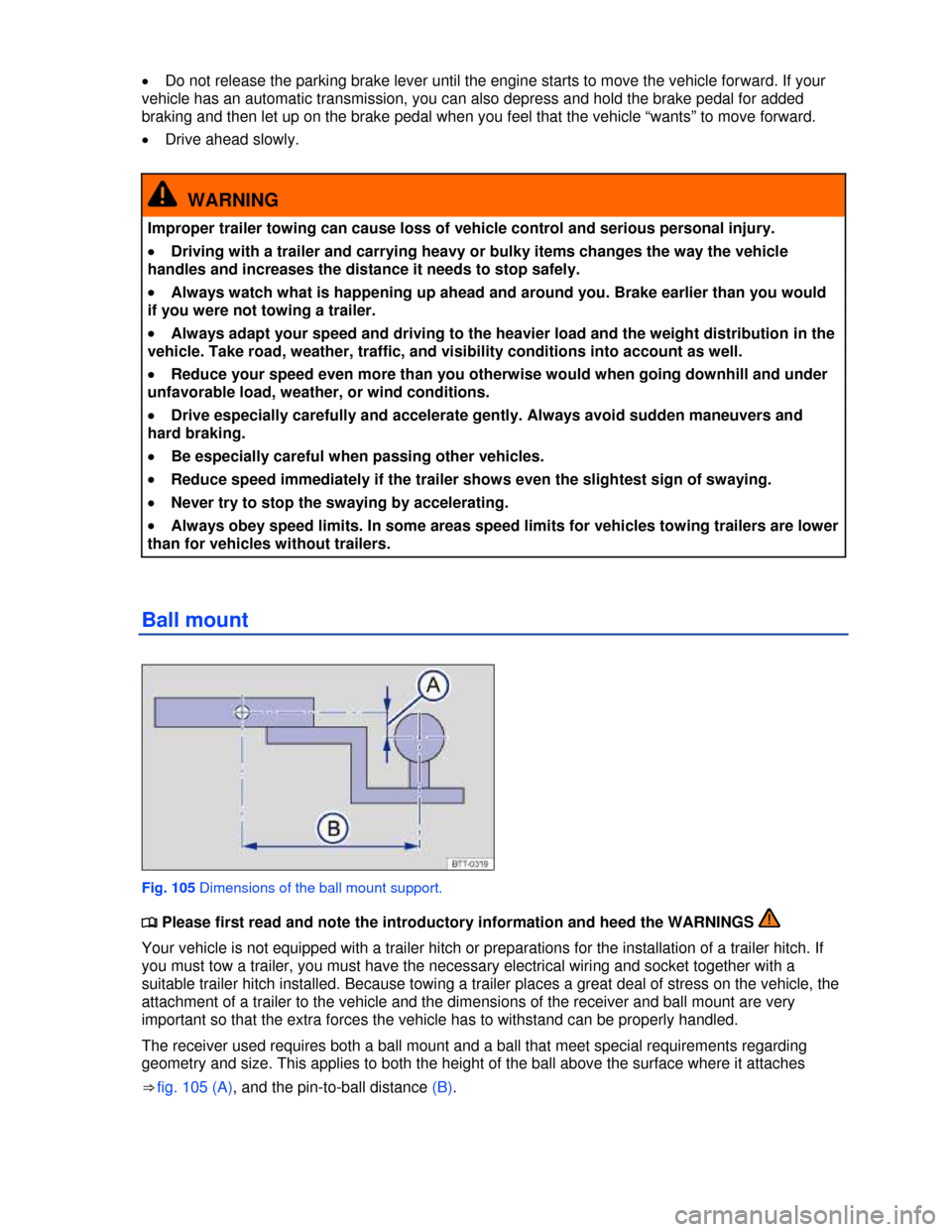
�x Do not release the parking brake lever until the engine starts to move the vehicle forward. If your
vehicle has an automatic transmission, you can also depress and hold the brake pedal for added
braking and then let up on the brake pedal when you feel that the vehicle “wants” to move forward.
�x Drive ahead slowly.
WARNING
Improper trailer towing can cause loss of vehicle control and serious personal injury.
�x Driving with a trailer and carrying heavy or bulky items changes the way the vehicle
handles and increases the distance it needs to stop safely.
�x Always watch what is happening up ahead and around you. Brake earlier than you would
if you were not towing a trailer.
�x Always adapt your speed and driving to the heavier load and the weight distribution in the
vehicle. Take road, weather, traffic, and visibility conditions into account as well.
�x Reduce your speed even more than you otherwise would when going downhill and under
unfavorable load, weather, or wind conditions.
�x Drive especially carefully and accelerate gently. Always avoid sudden maneuvers and
hard braking.
�x Be especially careful when passing other vehicles.
�x Reduce speed immediately if the trailer shows even the slightest sign of swaying.
�x Never try to stop the swaying by accelerating.
�x Always obey speed limits. In some areas speed limits for vehicles towing trailers are lower
than for vehicles without trailers.
Ball mount
Fig. 105 Dimensions of the ball mount support.
�
Page 160 of 319
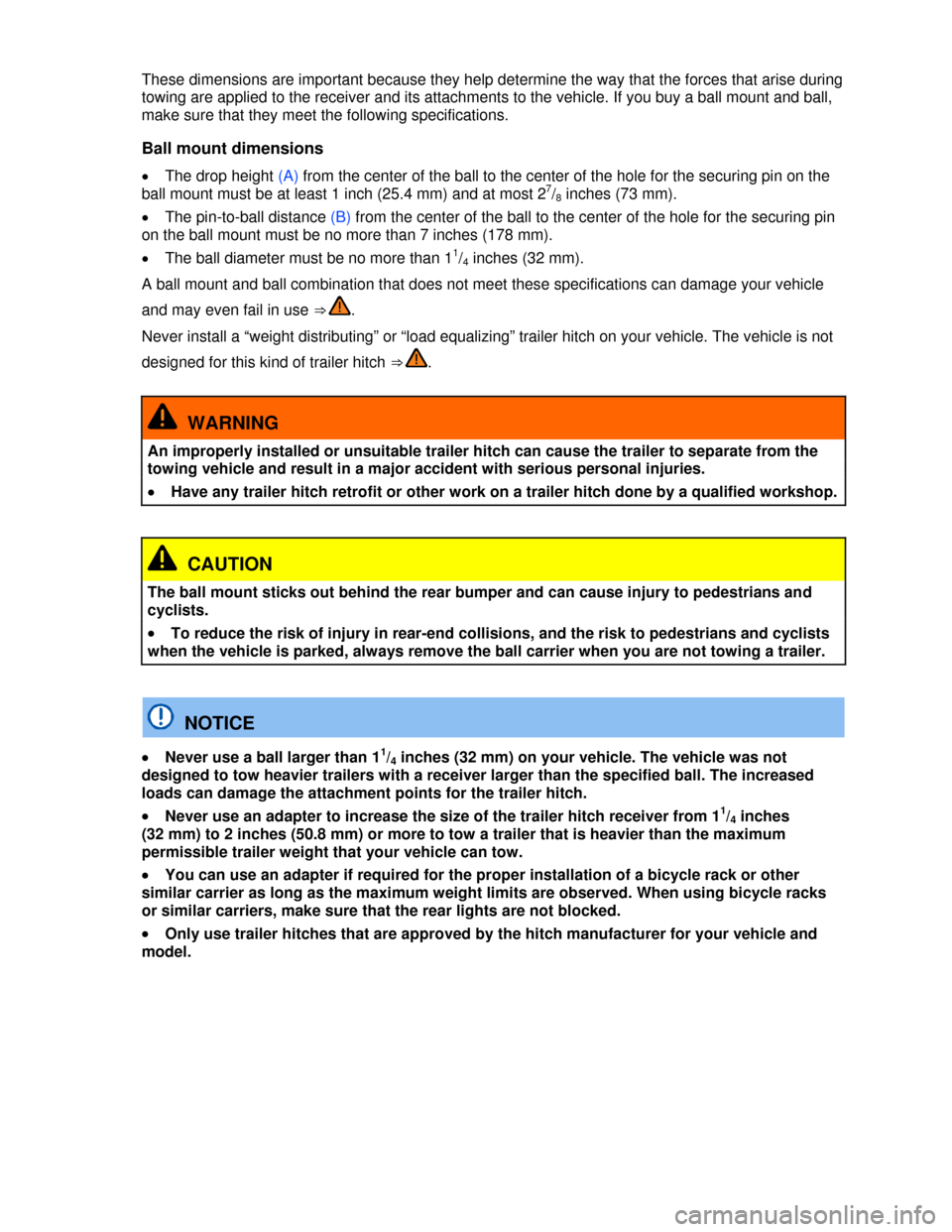
These dimensions are important because they help determine the way that the forces that arise during
towing are applied to the receiver and its attachments to the vehicle. If you buy a ball mount and ball,
make sure that they meet the following specifications.
Ball mount dimensions
�x The drop height (A) from the center of the ball to the center of the hole for the securing pin on the
ball mount must be at least 1 inch (25.4 mm) and at most 27/8 inches (73 mm).
�x The pin-to-ball distance (B) from the center of the ball to the center of the hole for the securing pin
on the ball mount must be no more than 7 inches (178 mm).
�x The ball diameter must be no more than 11/4 inches (32 mm).
A ball mount and ball combination that does not meet these specifications can damage your vehicle
and may even fail in use ⇒ .
Never install a “weight distributing” or “load equalizing” trailer hitch on your vehicle. The vehicle is not
designed for this kind of trailer hitch ⇒ .
WARNING
An improperly installed or unsuitable trailer hitch can cause the trailer to separate from the
towing vehicle and result in a major accident with serious personal injuries.
�x Have any trailer hitch retrofit or other work on a trailer hitch done by a qualified workshop.
CAUTION
The ball mount sticks out behind the rear bumper and can cause injury to pedestrians and
cyclists.
�x To reduce the risk of injury in rear-end collisions, and the risk to pedestrians and cyclists
when the vehicle is parked, always remove the ball carrier when you are not towing a trailer.
NOTICE
�x Never use a ball larger than 11/4 inches (32 mm) on your vehicle. The vehicle was not
designed to tow heavier trailers with a receiver larger than the specified ball. The increased
loads can damage the attachment points for the trailer hitch.
�x Never use an adapter to increase the size of the trailer hitch receiver from 11/4 inches
(32 mm) to 2 inches (50.8 mm) or more to tow a trailer that is heavier than the maximum
permissible trailer weight that your vehicle can tow.
�x You can use an adapter if required for the proper installation of a bicycle rack or other
similar carrier as long as the maximum weight limits are observed. When using bicycle racks
or similar carriers, make sure that the rear lights are not blocked.
�x Only use trailer hitches that are approved by the hitch manufacturer for your vehicle and
model.
Page 162 of 319
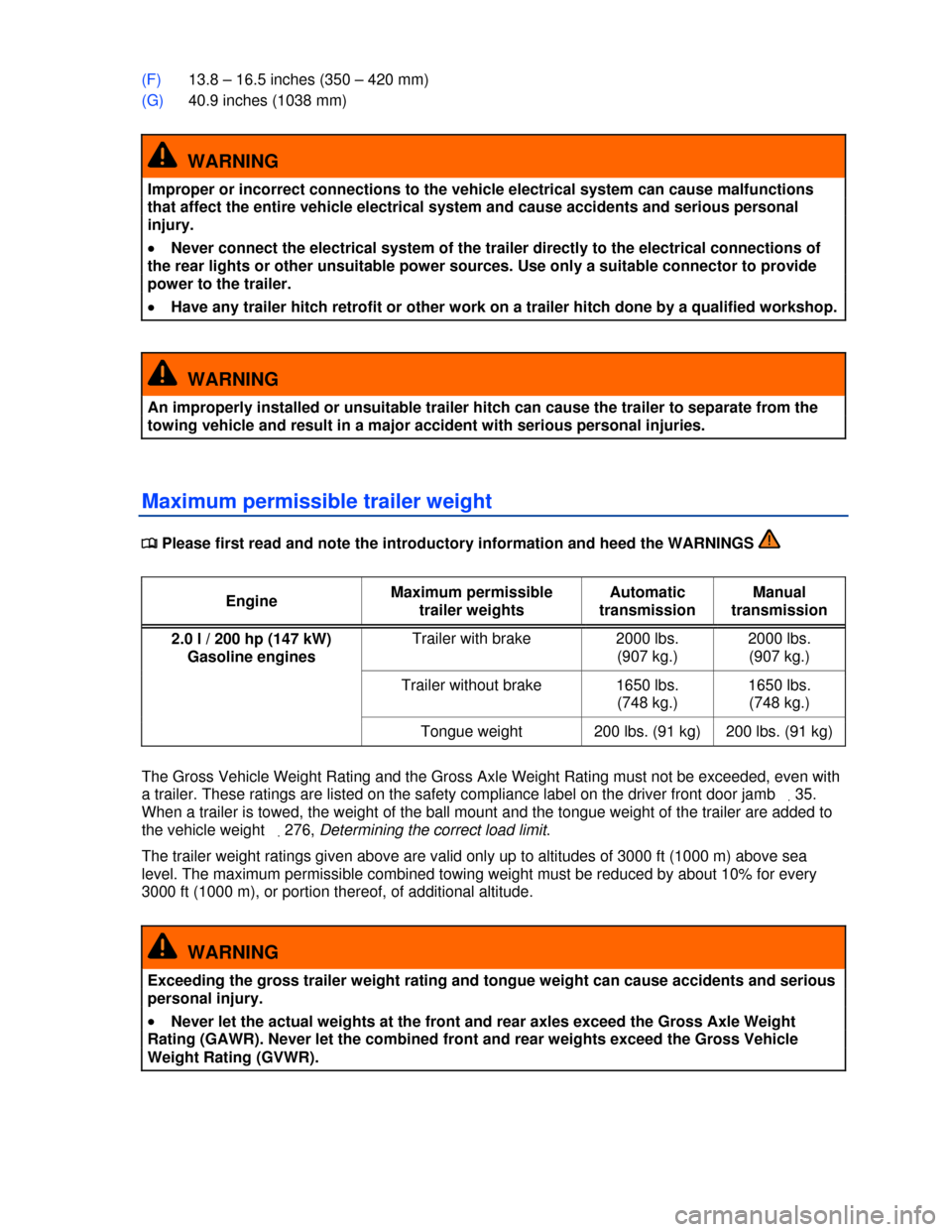
(F) 13.8 – 16.5 inches (350 – 420 mm)
(G) 40.9 inches (1038 mm)
WARNING
Improper or incorrect connections to the vehicle electrical system can cause malfunctions
that affect the entire vehicle electrical system and cause accidents and serious personal
injury.
�x Never connect the electrical system of the trailer directly to the electrical connections of
the rear lights or other unsuitable power sources. Use only a suitable connector to provide
power to the trailer.
�x Have any trailer hitch retrofit or other work on a trailer hitch done by a qualified workshop.
WARNING
An improperly installed or unsuitable trailer hitch can cause the trailer to separate from the
towing vehicle and result in a major accident with serious personal injuries.
Maximum permissible trailer weight
�